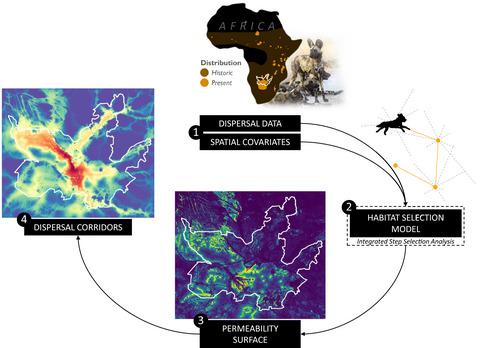当前位置:
X-MOL 学术
›
J. Appl. Ecol.
›
论文详情
Our official English website, www.x-mol.net, welcomes your
feedback! (Note: you will need to create a separate account there.)
Bound within boundaries: Do protected areas cover movement corridors of their most mobile, protected species?
Journal of Applied Ecology ( IF 5.0 ) Pub Date : 2021-05-06 , DOI: 10.1111/1365-2664.13868 David D. Hofmann 1 , Dominik M. Behr 1, 2 , John W. McNutt 2 , Arpat Ozgul 1 , Gabriele Cozzi 1, 2
中文翻译:

界限内:保护区是否覆盖了其最易流动的受保护物种的移动走廊?
更新日期:2021-06-02
Journal of Applied Ecology ( IF 5.0 ) Pub Date : 2021-05-06 , DOI: 10.1111/1365-2664.13868 David D. Hofmann 1 , Dominik M. Behr 1, 2 , John W. McNutt 2 , Arpat Ozgul 1 , Gabriele Cozzi 1, 2
Affiliation

|
- Conserving and managing large portions of land to connect wildlife reserves is an increasingly used strategy to maintain and restore connectivity among wildlife populations. Boundaries of such conservation areas are often determined based on expert opinion and socio-political constraints, yet the extent to which they match species' movement corridors is rarely examined. This is mainly due to a lack of data, particularly on wide-ranging movement behaviour such as dispersal. Nevertheless, empirically assessing the adequacy of protected areas is key for the implementation of targeted management actions and efficient use of limited conservation funds.
- Between 2011 and 2019, we collected high-resolution GPS data on 16 dispersing African wild dog Lycaon pictus coalitions from a free-ranging population in the Kavango–Zambezi Transfrontier Conservation Area (KAZA-TFCA). Spanning five countries and 520,000 km2, the KAZA-TFCA is the world's largest transboundary conservation area and a prime example for international conservation efforts. We used integrated step selection analysis to estimate habitat selection of dispersers and to create a permeability surface for the KAZA-TFCA. We compared landscape permeability across different regions within the KAZA-TFCA as well as outside its boundaries. Lastly, we calculated least-cost paths and corridors to verify that major movement routes were adequately encompassed within the KAZA-TFCA.
- Permeability within the boundaries of the KAZA-TFCA was more than double compared to areas outside it. Furthermore, we observed a fivefold permeability difference among the five KAZA-TFCA countries. We also showed that major movement corridors of wild dogs ran within the KAZA-TFCA, although some minor routes remained formally unprotected.
- Differences in permeability were mainly related to different degrees of human activities across regions, and to the presence or absence of rivers, swamps and open water. The relationship between permeability and other landscape features was less pronounced.
- Synthesis and applications. In this study, we showed how pertinent dispersal data of a highly mobile species can be used to empirically evaluate the adequacy of already existing or planned protected areas. Furthermore, we observed regional differences in landscape permeability that highlight the need for a coordinated effort towards maintaining or restoring connectivity, especially where transboundary dispersal occurs.
中文翻译:

界限内:保护区是否覆盖了其最易流动的受保护物种的移动走廊?
- 保护和管理大部分土地以连接野生动物保护区是一种越来越多的用于维持和恢复野生动物种群之间连通性的策略。此类保护区的边界通常是根据专家意见和社会政治限制确定的,但很少研究它们与物种运动走廊的匹配程度。这主要是由于缺乏数据,特别是关于广泛的运动行为,例如散布。然而,对保护区的充足性进行实证评估是实施有针对性的管理行动和有效利用有限保护资金的关键。
- 2011 年至 2019 年期间,我们从卡万戈-赞比西河跨境保护区 (KAZA-TFCA) 的自由放养种群中收集了 16 个分散的非洲野狗Lycaon pictus联盟的高分辨率 GPS 数据。KAZA-TFCA跨越五个国家和 520,000 公里2,是世界上最大的跨界保护区,也是国际保护工作的典范。我们使用综合步骤选择分析来估计分散者的栖息地选择并为 KAZA-TFCA 创建渗透表面。我们比较了 KAZA-TFCA 及其边界外不同区域的景观渗透率。最后,我们计算了成本最低的路径和走廊,以验证 KAZA-TFCA 内是否充分包含了主要运动路线。
- KAZA-TFCA 边界内的渗透率是其外区域的两倍多。此外,我们观察到五个 KAZA-TFCA 国家之间的渗透率差异为五倍。我们还展示了野狗的主要活动走廊在 KAZA-TFCA 内运行,尽管一些次要路线仍然没有正式保护。
- 渗透率的差异主要与不同地区人类活动程度的不同,以及河流、沼泽和开阔水域的存在与否有关。渗透率与其他景观特征之间的关系不太明显。
- 合成与应用。在这项研究中,我们展示了如何使用高度流动物种的相关扩散数据来经验性地评估现有或计划的保护区的充分性。此外,我们观察到景观渗透性的区域差异,这突出表明需要协调努力以维持或恢复连通性,尤其是在发生跨界扩散的情况下。











































 京公网安备 11010802027423号
京公网安备 11010802027423号